

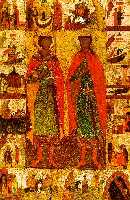

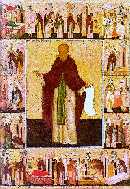

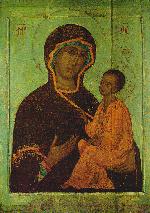
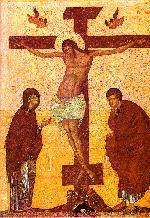
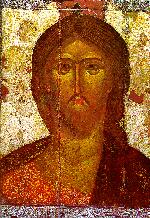
Moscow School icons: From top to bottom and from left to right: Saints Boris and Gleb, with Scenes from Their Lives (ca. 1330-1350), The Virgin of Vladimir, with Scenes from the Life of Christ and with Selected Saints (1515-1519), St. Sergius of Radonezh, with Scenes from His Life (early 16th c.), Blessed Are the Soldiers of the Heavenly King (The Church Militant) (1550s), The Virgin Hodegetria of Tikhvin (middle of the 16th c.), The Crucifixion (end of the 14th c.), The Savior (ca. 1330).
From Moscow's obscure beginnings in the twelfth century as a small village, it developed steadily to become the spiritual and political heart of Russia in the fifteenth century. During this time, the art of icon painting developed under the influence of the changing political and religious atmosphere that shaped the character of Moscow itself. Although isolated from much Western influence because of its historical ties with the Byzantine Church, Moscow became an important collector of Byzantine icons, which in turn colored the development of the Muscovite style. Because of the frequent devastating fires in Moscow in the fifteenth century, it is difficult to trace the development of early Muscovite painting. However, the appearance of Andrei Rublev and Dionisii (Dionysius), two important masters of Russian icon painting, shows that despite limited evidence, Moscow had been steadily developing an independent and unique painting style.
While Novgorod reached its peak in icon painting between the fourteenth and late fifteenth centuries, Moscow's development continued and reached its greatest achievements in the sixteenth century. The different social, geographical, and political position of each region in turn influenced the development and spirit of its icons. While there are similarities in their styles, the Moscow style, reaching its peak after the political subjugation of the unruly republic of Lord Novgorod the Great, took these similarities to another level.
Since Moscow's art had traditional ties with that of the Byzantine Church, new developments in Muscovite style can be traced by contrasting them with their Byzantine heritage. One important development was the change from the severe, harsh portrayal of the Pantokrator as found in the Byzantine models, to the more gentle, compassionate-looking Pantokrator, perfectly rendered by Andrei Rublev. Not only did his image of the Pantokrator differ from Byzantine images, but it also contrasted with the "traditional linearism" found in Novgorodian representations of Christ. This move towards a gentler and softer style of painting, which puts more emphasis on blending of warm colors than on sharp outlines, is characteristic of the Moscow school in particular, and the art of Russia in general.
Important developments in the Moscow school can be seen through the works of four masters of icon painting: Theophanes the Greek, Andrei Rublev, Dionisii (Dionysius), and Simon Ushakov. Theophanes the Greek (ca. 1330-ca. 1410) was known for his quick and skillful representation of figures, as well as for his characteristic use of monochromatic colors (in frescoes) and bright highlights to create depth and contour. Andrei Rublev (c.1370-1430) was probably influenced by Theophanes, but developed his own unique style that was, and still is, highly valued for its sense of unity and spiritual depth. His most famous work, The Old Testament Trinity, served as a prototype, highly praised and endorsed by the Russian Orthodox Church as an example for future representations of the Godhead. Although Dionisii' fame was widespread in the writings of his time, little of his prolific output remains today (most popular are the icons of The Crucifixion and The Virgin Hodegetria, two hagiographical icons of the Metropolitan Alexis and the Metropolitan Peter, and the frescoes in St. Therapont Monastery). His style was a continuation of the "intense spirituality and delicate coloristic grace" (Hamilton) characteristic of the Moscow school after Rublev . Finally, Simon Ushakov (1626-1686), the head of the "tsar's icon painters," brought the icon painting to its ultimate baroque apogee and, from the Orthodox point of view, demise. His Western-influenced faces of Christ and the Virgin, while truly beautiful, take the icon painting out of the spiritual realm into the real world. These four icon painters profoundly affected the art of their times and the development of the Moscow school of icon painting.
The Moscow school of icon painting can be characterized by several common features:
increased complexity in compositions and theological symbolism
more tender representations of Christ and the saints
considerable elongation of figures
warm, saturated colors and more variation in their selection, including the introduction of pastels
increasing degree of miniaturization, leading in the 16th century to Stroganov School, in the 17th to the art of the tsar's icon-painters (partially influenced by Western art), and in the 18th century to local icon-painting workshops (Palekh, Mstera)
"realistic" tendency as seen in parsunas (influence of Western art). [B.B. and C.B.]
[Source: Hamilton].
